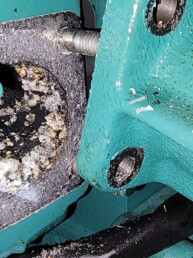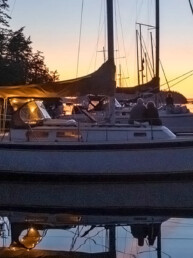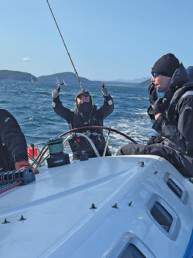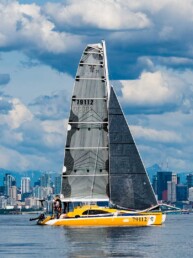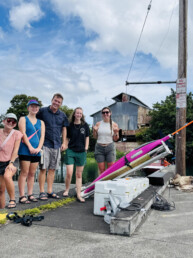This article was originally published in the April 2022 issue of 48° North.
It’s a rare sailor who is unfamiliar with the illness dubbed “one-foot-itis,” a malady which infects its hosts with the inexorable yearning for larger craft. Having always owned beachable, trailer-based boats, I’ve long considered myself resistant to this bug — that is, until I had the desire to sail more with my wife, and she with me.
Intellectually, Kate embraced my small boat sailing manifesto: simple, quiet, self-propelled. But as a non-sailor, her vision also included a measure of coziness, like a little cabin where two could sleep in comfort and she could retreat with a good book.
Adding the heft of fixed shelter, along with another crew member, seemed to challenge the nimbleness and freedom I’d enjoyed with my small craft. Would I need a bigger vehicle
to haul a larger, heavier vessel? And what about maintaining and storing a boat we might use only rarely? Most of all, I had to admit that I was intimidated by owning an engine
of any sort and chafed at the prospect of being beholden to it on windless days.

On a solo journey, I’m at peace with the balance of risk and comfort entailed in being motorless. In particular, it means I can’t just zoom out of an unpleasant situation or meet a schedule with the flick of a switch. But with my wife aboard, I knew the scales would need to tip toward comfort and an increased margin of safety. I wasn’t sure how I’d feel about that — until my friend Doug mentioned that he was thinking of selling Aluna, a charming catboat that seemed small enough to align with my manifesto, yet big enough to keep Kate feeling safe and relaxed.
Uncertain if I was ready to buy a new-to-me boat, I asked if we could borrow Aluna for a long weekend trial. When Doug said yes, Kate and I had an enviable, no-commitment opportunity to see for ourselves what adding a foot and a half in length, a snug cabin, and a few strakes would do for fun and comfort, compared to my elegant but utilitarian open boat, Row Bird.
With main and mizzen sails, a canoe paddle, and a five-horse outboard motor, 19-foot Aluna had choices of propulsion. Arriving at the launch ramp, I clenched my teeth and smiled while Doug gave an enthusiastic tutorial on how to run said motor. Despite my desire to sail off the dock, getting out of the marina and through the entrance channel in an unfamiliar boat under sail seemed unwise; so I gulped, pulled the starter rope, and we motored out into Budd Inlet near Olympia.
A few minutes later, I set the mizzen, then scrambled on deck to hoist the mainsail’s throat and peak halyards. When I hauled in the mainsheet, Aluna steadily built up speed. The movement of the lapstrake hull over the water produced a soothing gurgle. “Wow, I didn’t realize how loud that motor was,” Kate said, “until you turned it off.”
I had planned an easy first day of a dozen miles that would end at a friend’s dock in the shallows of Henderson Inlet. The sailing was smooth and relaxed. Row Bird, like a racing dinghy, requires constant shifting to sail well, but Aluna’s beaminess meant that the crew could sit wherever they wanted. I was happy at the tiller, gazing at the horizon, focusing on the sails. Kate nested wherever she pleased; on the cabin top, on a side bench, in the cabin.

waters of south Puget Sound.
We passed familiar landmarks like the Lilliputian lighthouse at Boston Harbor, the tight entrance to Big Fishtrap Cove, and a cluster of busy vacation homes, before turning into Henderson Inlet, where the wind completely died. I was determined not to succumb to the motor, so after waiting a suitably long time in vain for even a trickle of breeze, I grabbed the paddle.
With Kate at the helm, I summoned my strength and focused on propelling Aluna forward. What had been a mild day suddenly seemed hot as I stared at the three long miles that separated us from wine, lasagna, and the company of good friends. After 15 sweaty minutes of paddling, the boat had moved only a few hundred feet, never going more than half a knot. Admitting defeat, I turned on the engine and we chugged to the dock.
As we settled into the cabin for the night and reflected on the day, I had to concede that the motor, while annoying, had a role. Kate had enjoyed the view from her perch atop
the hatch and found the little cabin a comfy spot for reading. Sailing in Aluna, we agreed, was a pleasant way to get around on the water together.
Sleeping aboard started well. With a few small lanterns, the ambiance in the cabin was warm and cozy. Unlike Row Bird’s tent, the condensation from the marine layer didn’t cling overhead, waiting to drip on an unwary sleeper.
With the centerboard up, Aluna draws only a foot. Still, our hosts had warned us that with the night’s low tide, we might touch bottom. At around 3 a.m. I awoke to find the boat leaning slightly to port. I had assumed she would sit flat in the mud should the worst happen. Was she now positioned on her stubby keel, or were we about to tip over with a jarring bump? I leaned as much to starboard as I could, hoping to keep from finding out, but soon I was wide awake, lying in the turn of the bilge as the boat, leaning on its side, was high and dry. Kate, cradled against the centerboard trunk, sleepily asked if we were ok, then dozed off. By sunrise, we were fully afloat again. “Let’s not let that happen again,” she requested.
Over the next two days we ghosted along, sailed through gusts in the 20s, and used the motor when caution or necessity required. Kate learned a few things about how the boat worked, and I slowly changed my viewpoint from that of a lone explorer to a guide and partner.
True, Aluna wasn’t quite as exciting as the open boats that I’m accustomed to. But the steadiness of a larger craft allowed me to feel more relaxed while still enjoying a sense of adventure — because I was seeing and experiencing a familiar place in new ways and through Kate’s eyes. And with enough space for each of us to do our thing, I began to think that Aluna might be the boat for us, even with that motor.
Bruce Bateau
Bruce Bateau sails and rows traditional boats with a modern twist in Portland, Ore. His stories and adventures can be found at www.terrapintales.wordpress.com

